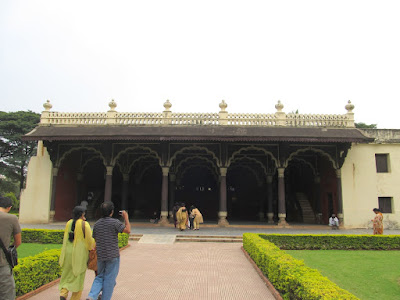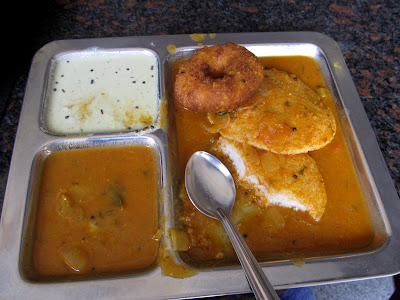 I arrived in Bangalore on Friday and will be heading out Tuesday night on an overnight train to Kochi (in the state of Kerala). It’s a brief visit to Bangalore and is mainly one of sightseeing rather than working on my project specifically. As I mentioned previously, I’m staying in the apartment of Sheila, the college student whose family I met in Mysore. I spent the first two days on my own figuring out the city, bargaining with auto rickshaw drivers, and seeing the sights. Sheila just arrived here last night (she spent two days in Mysore longer than I did to get in some study time) and it’s nice to get a glimpse into the life of a Bangalore college student. She has exams tomorrow and I’ve been trying to ease her pain by making a batch of good old American guacamole as she gears up for an all-nighter (I have so been there….).
I arrived in Bangalore on Friday and will be heading out Tuesday night on an overnight train to Kochi (in the state of Kerala). It’s a brief visit to Bangalore and is mainly one of sightseeing rather than working on my project specifically. As I mentioned previously, I’m staying in the apartment of Sheila, the college student whose family I met in Mysore. I spent the first two days on my own figuring out the city, bargaining with auto rickshaw drivers, and seeing the sights. Sheila just arrived here last night (she spent two days in Mysore longer than I did to get in some study time) and it’s nice to get a glimpse into the life of a Bangalore college student. She has exams tomorrow and I’ve been trying to ease her pain by making a batch of good old American guacamole as she gears up for an all-nighter (I have so been there….). Bangalore is the 3rd most populus city in India (right behind Mumbai and Delhi). It’s the capital of the state of Karnataka (in which Mysore is also located). Bangalore is supposedly the “Silicon valley” of India, and it’s said that a few years ago you could get wi fi anywhere on the street. Unfortunately, my timing is off and these days I’m finding it very hard to find wi fi here without paying for it. A bit of history stolen from the Lonely Planet: Apparently Bangalore remained “obscure” until 1759 when it was given to the sultan Hyder Ali by the King of Mysore (the one whose palace I’ve been to!) In 1809 the British arrived and in 1831 made Bangalore their administrative (at this point they also changed the name from Bengaluru to Bangalore…because you know, Bengaluru is SO hard to say). Fun fact: Winston Churchill used to love coming to Bangalore and supposedly left a debt (which is still recorded) of 13 rupees at the Bangalore Club. Shame on him.
With Pushpa (Sheila's mom) outside of the apartment.
Like most of the places I’ve visited in India so far, I’m finding Bangalore to be a wild juxtaposition of the very traditional and the very modern. Today it’s mainly a business center but it also has a lot of preserved green spaces which makes it a nice place to walk around. There is not a lot to see in Bangalore itself, so a lot of travelers just use it as an entry way into Southern India. I’ve been enjoying the city a lot so far though, and although it’s definitely much more urban than Mysore, by Indian standards, it’s still a pretty laid back place.
With this:
Next to this:
My first afternoon alone in Bangalore, I succumbed to doing the most touristy thing possible and took a bus tour of the city. The first stop? Bangalore’s science museum. I have to say that I have never seen so many people in a museum in my life. People were (literally) running around to cluster around exhibits and look at things, adding to the chaos was the fact that the gift shop seemed to be blasting a rendition of “Jingle Bells” throughout the entire space. Given all of this, I was already completely disoriented when I walked into an exhibition and found hundreds of women in sarees clustered around this:
Yep. That’s a replica of the Wright Brothers airplane in Bangalore.
(?)
I am ceasing to be surprised at what can only be described as the absolute and endearing randomness that I am finding pervades much of life here (at least from an American perspective). The first two sentences of the Lonely Planet guide to all of India are, “Bamboozling. There’s simply no other word that convincingly captures the enigma that is India.” Yep yep yep.
I also got a chance to see Bangalore’s assembly hall:
The Tipu Sultan’s palace: Long story short, for most of the time between 1327-1799, a series of Muslim sultanates ruled the state of Karnataka. The last one was Tipu Sultan, who was eventually defeated by the British and in fact, hated the British so much he designed an organ attached to a replica of a lion mauling a British officer. When you play the organ, you see the officer squirming in pain and hear the lion roar. I got to stare at this, um, interesting, contraption but unfortunately, photos were not allowed. Only a small part of the Tipu Sultan’s palace is left standing, but I think it’s been my favorite sight in Bangalore so far from an aesthetic perspective. I went a little photo-crazy and I’ll spare you the dozens of photos and just share these:
(I’m really hoping someone does some restoration work on this peeling paint soon because it is way too beautiful not to preserve).
Lalbagh Botanical Gardens: This is Bangalore’s largest green space with 96 acres of landscaped gardens. It makes for a lovely late afternoon walk.
Sheila also showed me around her campus. It’s called Christ University and is a 3-year B.A. program. Although it’s located in Bangalore, Sheila tells me most of its students are from Kerala. It was great to walk around with her and note some campus universals. I had to smile as she pointed out the “red benches” where she meets her friends between classes (Kohlberg Coffee Bar anyone?) I felt super nostalgic (and really old) sitting in her dining hall surrounded by a gaggle of 18 year-old girls as they ate their breakfast of idllis and sambar and tried to review together before their exam.
Sharples reborn
Slight change from my usual collegiate breakfast of an everything bagel, an orange and coffee.
Major differences include that there isn't a liberal arts style of education at her college; the students are heavily tracked into career paths. Most of them also live in hostels or apartments called “PGs” that are strictly monitored, most commonly by nuns who live with the students and impose a 6:30pm curfew. I’m really enjoying hearing Sheila’s anecdotes of students in Bangalore, like how many of her friends wear jeans and tank tops underneath their salwar kurtas and change in the school bathrooms once out of sight of the nuns or their parents. Interestingly, her university requires all the Indian girls to wear salwar kurtas or sarees to class but the foreign students (who are mainly Korean and Japanese) can wear whatever they want. (Her university is one of the few in the area that does not have a set uniform required by all students). I’ve also discovered that if I hail an auto rickshaw while wearing my backpack outside the university campus, my tourist appearance gets mistaken for a foreign student appearance and I tend to get better rates.
Sheila tells me most B.A. programs here require students to attend 75% of their classes in order to receive their degrees, but that her university is harder because it requires students to attend 85% of their classes. When asked, I tried to explain that at my college there wasn’t a requirement for how many classes we attend but that most people went to every class of their own accord. Then I realized how strange and idealistic that must sound.
On the plus side, Christ University has a bird garden (step it up, Scott arboretum).
Sheila on her beautiful campus.
p.s. Just so you all know, because I’m traveling around India so much in the coming weeks, my internet might be pretty sporadic, so you might not hear from me for a while and then, in typical fashion, hear from me a lot. (In other words, Mom, don't worry if I don't post for a while).



















terrific post. yes, butter fruit. and people eat it with sugar. i am certainly going to enter it on samosapedia.com--now, if you don't know it, it's about time you found out, now that you are becoming an Indian. btw, the meditator has a different identity on samosapedia.
ReplyDeletehope kerala for you is all that it is meant to be. and i very much hope that your hotel issue was sorted out in kanyakumari (used to be called cape comorin).
This comment has been removed by the author.
ReplyDelete